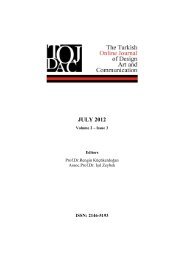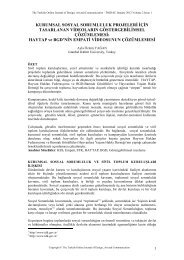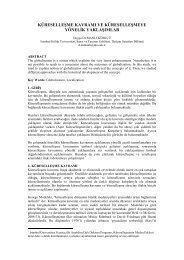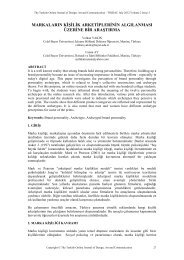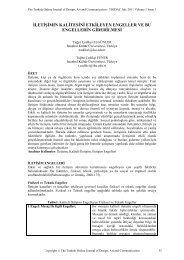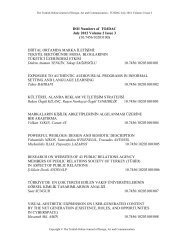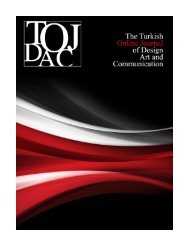aprıl 2012 - tojdac.org
aprıl 2012 - tojdac.org
aprıl 2012 - tojdac.org
Create successful ePaper yourself
Turn your PDF publications into a flip-book with our unique Google optimized e-Paper software.
The Turkish Online Journal of Design, Art and Communication - TOJDAC April <strong>2012</strong> Volume 2 Issue 2<br />
1- Split screen photography.<br />
3- Glass shot.<br />
2- In the camera matte shot.<br />
4- Mirror shot.<br />
2- Laboratory processes: in which duplication of the original negative through one or<br />
more generation is necessary before the final effect is produced:<br />
A. Bi – pack printing.<br />
B. Optical printing.<br />
C. Travelling mattes.<br />
D. Aerial – image printing.<br />
3- Combination techniques: some of the image components are photographed directly on<br />
to the final composite film, while others are produced through duplication or before<br />
shooting:<br />
A. Background projection<br />
1- Rear projection. 2- Front projection. [10]<br />
Some of the visual effects can be done with several techniques and the cinematographer will<br />
decide the suitable technique. The choice of which technique to be used was mainly based on<br />
the image quality, nature of the scene, desired effect on the screen and the cost.<br />
4.2. Motion Controlled Cameras<br />
Borrowing technology from developments in sound in the late 1940s and early 1950s, visual<br />
effects artists adapted the use of synchronous motors to control pans, tilts, and dolly moves.<br />
This allowed for accurately duplicating a camera move shot on one set or location with a<br />
matching move back on the lot in the visual effects department. The gear was clumsy, and<br />
true-frame accurate recording and playback of moves was not always possible or consistent,<br />
but this precursor to motion control of film cameras provided visual effects artists with<br />
another tool to meet the growing demands of directors and camera people for more innovative<br />
shots. [11]<br />
The use of motion-controlled cameras on set has been a great boon for actor duplication and<br />
interaction. In such scenes, the lighting is exactly the same for each take, and the two performances<br />
can be choreographed to interact precisely. A great example of this type of work<br />
can be found in the Back to the Future films (1985–1990) and The Lord of the Rings trilogy,<br />
in which actors of different scales (meaning same size actors) were made to look like giants or<br />
dwarves interacting with one another. [12]<br />
Nowadays with the aid of computer engineering and programming the motion control camera<br />
has a system for the identical repetition of camerawork by computer control. It can, for<br />
example, be used to convert a few extras into a crowd of thousands by multiplying images, or<br />
prepare a CG background for a real scene using the sequential camera data of the original<br />
shooting. Special operations of this kind require use of a very precise motion control camera<br />
with great repeatability and cannot be performed by manual camera work. The motion control<br />
camera has, therefore, come to be regarded as an essential system for VFX productions.[13]<br />
4.3. Front And Rear Projection<br />
Front and rear projection are both in-camera compositing techniques. By this we mean that<br />
two (and rarely three) separate images are combined into one image in-camera at the time of<br />
filming. In front projection, an image is projected through a beam-splitter placed in front of<br />
the camera onto a highly reflective Scotchlite screen. In rear projection (RP), the image that is<br />
to be combined with a live-action plate is projected from the rear onto a translucent screen,<br />
and the live action plays in front of it.[14] In the pre-digital era of visual effects, front<br />
projection, rear screen projection, and “side-screen” projection were processes used for<br />
creating large-scale sets and new environments as well as for moving images out the windows<br />
of cars and planes. Although the techniques for using these tools have changed a great deal,<br />
the mechanics of the tools are basically the same, except for the new digital projection<br />
systems. In the past the background plates had to be created prior to on-set shooting, and once<br />
the on-set shooting was done, there was no fixing it in post, but it did and still does allow one<br />
to shoot many versions of the action with the subjects to give the director a variety of takes<br />
Copyright © The Turkish Online Journal of Design, Art and Communication 118



